Corsair RM1000 Power Supply Review
by E. Fylladitakis on April 24, 2014 6:00 AM EST- Posted in
- Cases/Cooling/PSUs
- Corsair
- PSUs
- RM Series
Hot Test Results
From the tables below, it can be seen that the output power quality of the Corsair RM1000 is very good. The maximum voltage ripple that our instrumentation recorded was just above half of the ATX design guide suggested limit (the limits are 120 mV on the 12V line, 50 mV on the minor voltage lines), under full load and inside the hotbox. Cross-load testing negatively affects the power quality of any power supply, yet the RM1000 manages to pass the test, with the 12V line registering up to 98 mV while delivering a massive 800W.
| Main Output | ||||||||
| 203.84 W | 506.25 W | 752.95 W | 997.56 W | |||||
| 20.38% | 50.62% | 75.29% | 99.76% | |||||
| Line | Amperes | Volts | Amperes | Volts | Amperes | Volts | Amperes | Volts |
| 3.3 V | 4.14 | 3.40 | 10.36 | 3.37 | 15.53 | 3.34 | 20.71 | 3.30 |
| 5 V | 4.14 | 5.14 | 10.36 | 5.11 | 15.53 | 5.00 | 20.71 | 4.98 |
| 12 V | 13.80 | 12.21 | 34.50 | 12.13 | 51.76 | 12.04 | 69.01 | 11.97 |
| Line |
Regulation (20% to 100% load) |
Voltage Ripple (mV) | |||||
| 20% Load | 50% Load | 75% Load | 100% Load | CL1 12 V | CL2 3.3 V + 5 V | ||
| 3.3 V | 3.0% | 16 | 24 | 26 | 30 | 10 | 26 |
| 5 V | 3.1% | 18 | 26 | 30 | 36 | 12 | 30 |
| 12 V | 1.95% | 26 | 30 | 54 | 70 | 98 | 24 |
The impact that the higher ambient temperature has on the energy conversion efficiency is virtually miniscule, reducing the average nominal load (20-100%) efficiency of the RM1000 from 91.8% down to 91.4%. This is an excellent result for such a powerful power supply, especially when the ambient air temperature increased by more than 20 °C.
The large increase in the ambient air temperature naturally has an effect on all of the temperature readings. This time the fan starts a bit earlier, at 40% load, and its speed increases rapidly, obviously reacting to the high heat. The speed of the fan virtually maxes out at 70% load, with the cooling system giving everything it has to keep the RM1000 cool enough. The fan becomes clearly audible but not overly loud even while the unit is severely stressed, but its speed cannot be increased any further and so it is unable to help the thermal performance of the RM1000 beyond a certain point.
While the power supply keeps operating just fine, the temperatures are significantly elevated, above what we consider a "comfortable limit". This however also is with an ambient temperature significantly higher than the 40 °C rating of this power supply, therefore the fact that it can keep delivering its maximum output and electrically perform well enough to maintain its specifications is quite a feat.


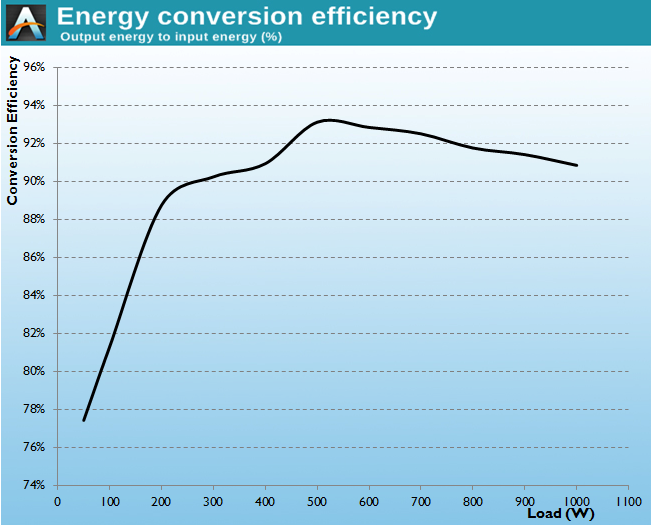
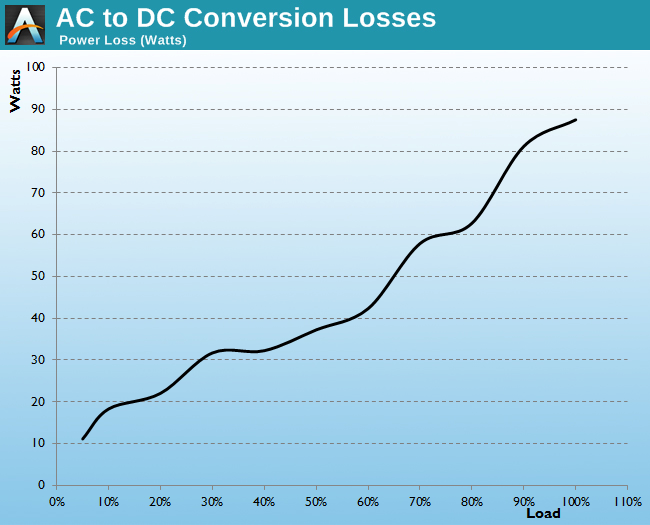
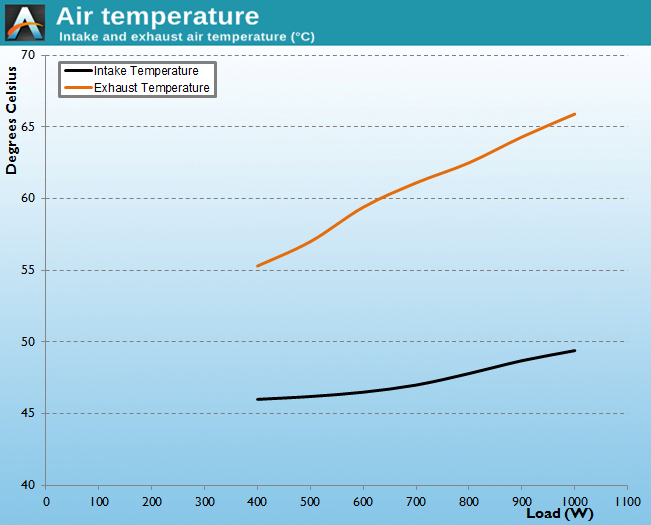
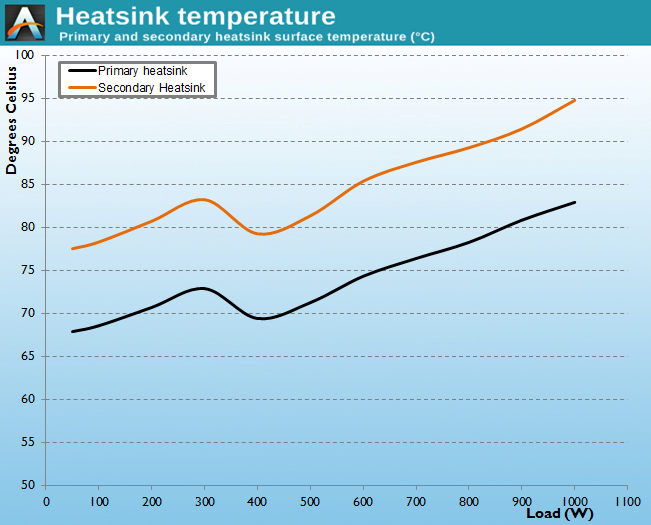
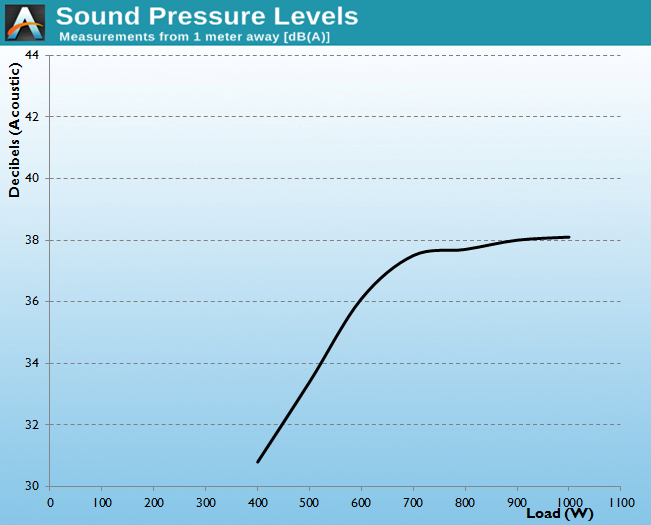








55 Comments
View All Comments
piroroadkill - Thursday, April 24, 2014 - link
Solid enough, but personally I have no love for Channel Well Technology.Streetwind - Friday, April 25, 2014 - link
Bit of a shortsighted notion... CWT is an OEM, they manufacture in exactly those quality levels that their customers request. If a customer asks for a cheap piece of crap, the OEM will produce them a cheap piece of crap. But if Corsair says that they need a high quality product, CWT builds them a high quality product. PSU production is not rocket science; it's all about how many corners you're willing to cut to drive the price down.dirtyferret - Thursday, April 24, 2014 - link
I've owned two CWT PSU and 5-6 seasonic OEM units. Maybe I was lucky but I never had any issue with the CWT units I have owned with both working well for 5+ years. I did get an antec (seasonic oem) with a bad coil, my other seasonic PSU never had an issue.tech6 - Thursday, April 24, 2014 - link
With CPUs and GPUs becoming more efficient there really is a very small market for 1kW PSUs. Even with dedicated mid-range gaming graphics cards, a lot of new PC never exceed 350W. I wish PSU makers would put as much effort into efficient and quiet low wattage products as they do with overkill products like these.2late2die - Thursday, April 24, 2014 - link
Well to be fair the entire RM line is geared towards quiet and efficient operation, so if you want that with low wattage just get the 450W unit. Of course 1kW units are geared towards the smaller enthusiast market, always have been and probably will always be. With that being said, if you want to build a powerful system (not necessarily cutting edge, but above mid-range) and keep quiet, then you want the 850W or 1kW unit because of the whole "no fan below 40%" thing. Like you said, many systems, even at load might not reach 40%, which just means that your 1kW unit will always work completely silently, so that's one less fan for you to worry about.Daniel Egger - Thursday, April 24, 2014 - link
That doesn't make sense. A high output unit will almost always have a higher loss and thus emit more heat. In other words: it's actually easier to produce a fanless 400W unit than to produce a 1000W unit that runs with a fan at 0 RPM below 400W.PEJUman - Thursday, April 24, 2014 - link
^^not exactly, you're correct for PSUs from 10 years ago, however the 80 certification requirements forces the modern PSU design to be efficient at all loads:the 80 gold requirements: min efficiency @ 20% load = 0.87, 50% load at = 0.9, 100% load = 0.87
Therefore a 450W 80 Gold will only be 3% (6 Watts) more efficient than a 1000W 80 gold at 200W load.
Daniel Egger - Friday, April 25, 2014 - link
My point is this: If you want to build a system designed for 400W max output it does *not* make sense to use a 1000W just because it happens to run at 0RPM below 40% utilisation.BTW: Not sure your what you meant by "you're correct for PSUs from 10 years ago" because your own calculation proves that I'm still correct for current PSUs. 6W are nothing to sneeze especially considering that no decent system has an idle load of 200W, not even an unlocked haswell setup with crossfire r9 295x2 cf. http://www.anandtech.com/show/7930/the-amd-radeon-... (which this PSU couldn't drive anyway) and those figures are going to be much worse for sane setups.
owan - Friday, June 27, 2014 - link
He didn't say at Idle, he said 200W load. Considering that PSU's are most efficient at 50% load, it actually makes some sense to size your PSU to keep the max load closer to 50% than 100%, particularly if you run your system at high loads for a high percentage of its uptime (i.e. long rendering times, long gaming sessions with minimal other usage) With a high end system drawing well over 500W from the wall, a 1000W PSU is a perfectly sane choiceUnknownZA - Thursday, August 20, 2015 - link
The problem is that new GPU's like Maxw ell do draw more power. A normal 980 GTX Ti apparently only draws 250W which is excellent. However, most if not all of the overclocked 980 GTX Ti's that are on the market draw much more power.I have a GALAX 980 GTX Ti HOF and under full load it draws close to 480W.
I currently have a Corsair TX 750W which I thought was more than enough power for my system, currently Z68 with 2600K, but bought a 4790K and Z97 too. However I have had quite a few crashes while playing games and I have come to the conclusion that the PSU is not suppling enough power. So I am looking at this 1000W Corsair RM. I could go with the 850 but the price difference is negligible.